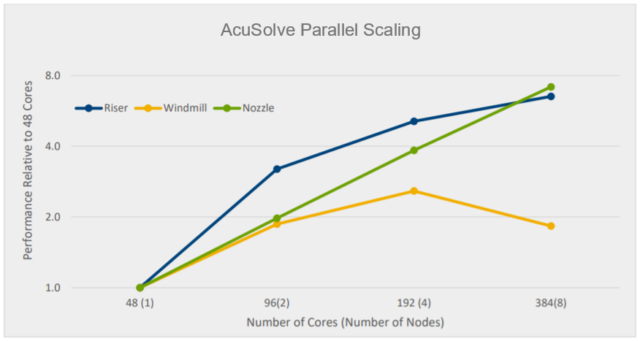With the amount of data being produced and collected, critical product design and digital manufacturing are increasingly more granular. At McLaren racing, the difference between finishing a race in the top five positions could be as little as 0.15%. The competition is so fierce that the disparity between the fastest and slowest cars is as small as 4%. To fine tune the car’s product design, McLaren collects 100,000 data points per second and runs billions of simulations per year.
The speed and granularity of these HPC workloads is dependent on CPU cache and number of nodes. As the number of nodes increases, the complexity of communication between nodes also increases, making cache per socket extremely important. This relationship is important for both CPU cache and memory cache.
To improve the performance of these HPC workloads, the Dell PowerEdge team is proud to announce the support for the new 3rd Gen AMD EPYC™ processors with AMD 3D V-Cache™ technology. By tripling the L3 cache to 768MB¹ and optimizing data latency, PowerEdge with AMD EPYC 7003 Series processors with AMD 3D V-Cache can improve HPC performance, specifically for technical computing.²
Technical workloads running on 3rd Gen AMD EPYC processors with AMD 3D V-Cache technology can see performance increases of a max 61% for CFD on Ansys® CFX® and up to 56% max for FEA on Altair Radioss™ compared to AMD EPYC 7003 processors without 3D V-Cache.3,4 Keeping the data close to the processor is also important for workloads such as SAP. The PowerEdge R7525 with AMD EPYC 7773X CPU set a new world record and ran 86,000 users on the SAP SD benchmark. This is a 14% improvement over the previous world record.
The increased L3 cache also supports digital manufacturing workloads by improving memory latency and bandwidth. Because the amount of L3 cache is tripling compared to AMD EPYC processors without 3D V-Cache, applications that require high memory bandwidth can benefit significantly. Applications such as computational fluid dynamics and finite element analysis can benefit the most. Dell has also seen a reduction on memory latency of approximately 25-35%. This reduction will benefit RTL simulations and even has implications for HPC in the financial industry.
Rack space is incredibly important for these HPC workloads. Customers wanting to hit the sweet spot between performance, power and cooling and licensing costs will be excited about our 1-socket options (R6515 and R7515) paired with the 32 and 64 core processors. The complete stack of 3rd Gen AMD EPYC processors with AMD 3D V-Cache technology are great for the 2-socket platforms.
Even though these processors are positioned for very specific applications and workloads, there are long-term implications for AMD innovations. The improved memory latency comes for an innovation made in the CPU design, and it could benefit Dell and AMD customers going forward.
We are excited to support these new features and want to be with our customers every step of their digital transformation journey. Stay tuned at Dell.com to keep up to date will all of Dell PowerEdge with AMD EPYC innovations.
¹ AMD EPYC™ 7003 Processors with AMD 3D V-Cache have 768MB of L3 Cache, while EPYC 7003 processors without AMD 3D V-Cache have up to 256MB. MLNX-12
² “Technical Computing” or “Technical Computing Workloads” as defined by AMD can include electronic design automation, computational fluid dynamics, finite element analysis, seismic tomography, weather forecasting, quantum mechanics, climate research, molecular modeling, or similar workloads. GD-204
³ 2x 64-core pre-production AMD EPYC™ 7773X complete up to ~48% more CFD problems solved/day compared to the 2x EPYC 7763 on ANSYS® CFX®
MLNX-002: ANSYS® CFX® 2021.1 comparison based on AMD internal testing as of 5/22/2021 measuring the time to run the Release 14.0 test case simulations. Configurations: 2x pre-production 64C/32C AMD EPYC “Milan-X” 7773X with AMD 3D V-Cache Technology enabled (32C data collected with other cores disabled to simulate a 7573X) versus 2x 64C AMD EPYC 7763/2x 32C EPYC 75F3 on AMD “Daytona” reference platform. Results may vary based on factors including silicon version, hardware and software configuration and driver versions.
4 2x 64-core AMD EPYC™ 7773X complete up to ~56% max more FEA explicit solver jobs/day compared to the 2x EPYC 7763 on Altair® Radioss®
MLNX-015: Altair® Radioss® 2021.2 comparison based on AMD internal testing as of 02/14/2022 measuring the time to run the dropsander, neon, and t10m test case simulations. Configurations: 2x 64C AMD EPYC 7773X with AMD 3D V-Cache™ versus 2x 64C AMD EPYC 7763 on the same AMD “Daytona” reference platform. neon is the max result. Results may vary based on factors including silicon version, hardware and software configuration and driver versions.




